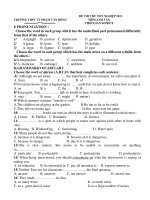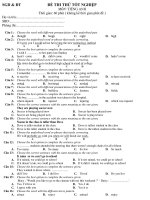- Trang chủ >>
- Khoa học tự nhiên >>
- Vật lý
Đề thi thử tốt nghiệp THPT tiếng Anh 2021 trường THPT Chuyên Lê Thánh Tông lần 1
Bạn đang xem bản rút gọn của tài liệu. Xem và tải ngay bản đầy đủ của tài liệu tại đây (138.36 KB, 8 trang )
<span class='text_page_counter'>(1)</span><div class='page_container' data-page=1>
<b>ĐỀ THI THỬ THPTQG MÔN TIẾNG ANH</b>
<b>NĂM 2021 CÓ ĐÁP ÁN</b>
<i><b>Read the following passage and choose the correct word or phrase that best fits each of the</b></i>
<i><b>numbered blanks.</b></i>
COVID-19 has forced us into social distancing, isolation and quarantine. These conditions are
likely fostering (1) _____ anxiety and loneliness in our cities. However, COVID-19 is an
opportunity to build a new kind of contact on (2) _____ we know and learn from this situation.
It's possible to promote social and emotional well-being. Integrating public and online spaces is
one of the approaches for building better communities. Our new online communication skills
can help us develop a better physical-digital interface for bringing people together. Video
conferencing is flexible and can enable long-distance connection and “work from home” hubs.
(3) _____, social media platforms, such as Facebook, Meetup, WhatsApp or art-based apps like
Somebody, are (4) ______ for organising physical meetings too. These can help with
community volunteering, socialising, or simply sharing guerrilla-garden herbs for local
cooking. A better physical-digital interface could help new jobs flourish in "interactive" creative
industries that virtually connect (5) ______ isolated individuals. New art spaces could be
established, putting connective digital infrastructure, such as audio-visual platforms, within
physical spaces to help face-to-face and virtual audiences interact.
<i>(Adapted from />
<b>Câu 1 (TH): </b> <b>A. national </b> <b>B. widespread </b> <b>C. global </b> <b>D.</b>
international
<b>Câu 2 (TH): </b> <b>A. that </b> <b>B. what </b> <b>C. whom </b> <b>D. which </b>
<b>Câu 3 (TH): </b> <b>A. In contrast </b> <b>B. Therefore </b> <b>C. Otherwise </b> <b>D. Moreover </b>
<b>Câu 4 (TH): </b> <b>A. grateful </b> <b>B. careful </b> <b>C. awful </b> <b>D. useful </b>
<b>Câu 5 (TH): </b> <b>A. another </b> <b>B. every </b> <b>C. other </b> <b>D. one </b>
<i><b>Choose the most suitable response to complete each of the following exchanges.</b></i>
<b>Câu 6 (TH): Mike's inviting Sue to go dancing.</b>
- Mike: "Shall we go dancing tonight?"
- Sue: “________________”.
</div>
<span class='text_page_counter'>(2)</span><div class='page_container' data-page=2>
<b>Câu 7 (TH): Mike and Susan are talking about changes in the modern society.</b>
- Mike: "Our living standards have been improved greatly."
- Susan: “_______________”
<b>A. Sure. I couldn't agree more. </b> <b>B. Yes, it's nice of you to say so. </b>
<b>C. No, it's nice to say so. </b> <b>D. Thank you for saying so. </b>
<i><b>Choose the word or phrase that is CLOSEST in meaning to the underlined part in each of</b></i>
<i><b>the following questions.</b></i>
<b>Câu 8 (VDC): You never really know where you are with her as she just blows hot and cold. </b>
<b>A. keeps testing </b> <b>B. keeps going </b>
<b>C. keep changing her opinion </b> <b>D. keeps taking things </b>
<b>Câu 9 (TH): With the Artemis program, NASA will land the first woman and next man on the</b>
Moon by 2024, using innovative technologies to explore more of the lunar surface than ever
before.
<b>A. crude </b> <b>B. rustic </b> <b>C. traditional </b> <b>D. latest </b>
<i><b>Choose the word that differs from the rest in the position of the main stress in each of the</b></i>
<i><b>following questions.</b></i>
<b>Câu 10 (TH): </b> <b>A. participant </b> <b>B. particular </b> <b>C. enthusiast </b> <b>D. preferential</b>
<b>Câu 11 (NB): </b> <b>A. technique </b> <b>B. finish </b> <b>C. reduce </b> <b>D. impress </b>
<i><b>Choose the underlined part that needs correction in each of the following questions.</b></i>
<b>Câu 12 (TH): Many places of (A) history, scientific, (B) cultural, or scenic (C) importance (D)</b>
have been designated national monuments.
<b>A. history </b> <b>B. cultural </b> <b>C. importance </b> <b>D. have been </b>
<b>Câu 13 (VD): The villagers are (A) highly appreciable of the (B) volunteers' efforts in (C)</b>
reconstructing their houses after the (D) devastating storm.
<b>A. highly appreciable </b> <b>B. volunteers' efforts C. reconstructing </b> <b>D.</b>
devastating
<b>Câu 14 (NB): Basic knowledge (A) of social studies, such as (B) history and geography, (C)</b>
are considered a basic part of the education of (D) every child.
<b>A. of </b> <b>B. history </b> <b>C. are </b> <b>D. every </b>
<i><b>Choose the correct answer to each of the following questions.</b></i>
<b>Câu 15 (VD): I don't think you know where she is, ______? </b>
</div>
<span class='text_page_counter'>(3)</span><div class='page_container' data-page=3>
<b>Câu 16 (VD): Yesterday, when I went shopping with my mother, we _____ my old teacher,</b>
who I hadn’t seen for nearly 15 years.
<b>A. ran into </b> <b>B. turned out </b> <b>C. took out </b> <b>D. saw with </b>
<b>Câu 17 (VD): As a parent, you should try to create a safe _____ environment for your children</b>
to grow up.
<b>A. house </b> <b>B. homing </b> <b>C. housing </b> <b>D. home </b>
<b>Câu 18 (VD): Ten million text messages are sent on _____ every minute. </b>
<b>A. normal </b> <b>B. common </b> <b>C. general </b> <b>D. average </b>
<b>Câu 19 (VD): The house was burgled while the family was _____ in a card game. </b>
<b>A. buried </b> <b>B. busy </b> <b>C. absorbed </b> <b>D. helping </b>
<b>Câu 20 (VDC): Am I nervous? Of course not. Look at my hand - it's as steady as _____. </b>
<b>A. a bridge </b> <b>B. a rock </b> <b>C. steel bars </b> <b>D. a stepladder </b>
<b>Câu 21 (TH): You don't usually have to go into _____ hospital to have your ears cleaned. The</b>
doctor can do it at the surgery.
<b>A. an </b> <b>B. x (no article) </b> <b>C. the </b> <b>D. a </b>
<b>Câu 22 (NB): If you _____ the lottery, what would you do with the money? </b>
<b>A. win </b> <b>B. had won </b> <b>C. will win </b> <b>D. won </b>
<b>Câu 23 (VD): Teacher, are we expected to learn all the new words _____ heart? </b>
<b>A. at </b> <b>B. to </b> <b>C. in </b> <b>D. by </b>
<b>Câu 24 (TH): It's worth _____ this book. </b>
<b>A. reading </b> <b>B. to read </b> <b>C. read </b> <b>D. being read </b>
<b>Câu 25 (NB): I have never played badminton before. This is the first time I _____ to play. </b>
<b>A. try </b> <b>B. tried </b> <b>C. have tried </b> <b>D. am trying </b>
<b>Câu 26 (TH): _____ extremely bad weather in the mountains, we're no longer considering our</b>
skiing trip.
<b>A. Due to </b> <b>B. Although </b> <b>C. Because </b> <b>D. Despite </b>
<b>Câu 27 (TH): She saw a mouse _____. </b>
<b>A. when she was having a bath </b> <b>B. as long as she had a bath </b>
<b>C. as she had had a bath </b> <b>D. as soon as she has had a bath </b>
<b>Câu 28 (VD): The song _____ by our listeners as their favorite of the week is "Goodbye Baby"</b>
by Tunesmiths.
</div>
<span class='text_page_counter'>(4)</span><div class='page_container' data-page=4>
<b>Câu 29 (TH): Mom left the chicken out on the table so that it could _____ slowly. </b>
<b>A. frosted </b> <b>B. frost </b> <b>C. frosty </b> <b>D. defrost </b>
<i><b>Read the following passage and choose the correct answer to each of the questions.</b></i>
Do you feel like your teenager is spending most of the day glued to a phone screen? You're not
too far off. A new survey from the Pew Research Center reveals the surprising ways that
technology intersects with teen friendships – and the results show that 57 percent of teens have
made at least one new friend online. Even more surprisingly, only 20 percent of those digital
friends ever meet in person.
While teens do connect with their friends face-to-face outside of school, they spend 55 percent
of their day texting with friends, and only 25 percent of teens are spending actual time with
their friends on a daily basis (outside of school hallways). These new forms of communication
are key in maintaining friendships day-to-day – 27 percent of teens instant message their friends
every day, 23 percent connect through social media every day, and 7 percent even video chat
daily. Text messaging remains the main form of communication – almost half of survey
respondents say it's their chosen method of communication with their closest friend.
While girls are more likely to text with their close friends, boys are meeting new friends (and
maintaining friendships) in the gaming world – 89 percent play with friends they know, and 54
percent play with online-only friends. Whether they're close with their teammates or not, online
garners say that playing makes them feel "more connected" to friends they know, or garners
they've never met.
When making new friends, social media has also become a major part of the teenage identity –
62 percent of teens are quick to share their social media usernames when connecting with a new
friend (although 80 percent still consider their phone number the best method of contact).
Despite the negative consequences-21 percent of teenage users feel worse about their lives
because of posts they see on social media – teens also have found support and connection
through various platforms. In fact, 68 percent of teens received support during a challenging
time in their lives via social media platforms.
Just as technology has become a gateway for new friendships, or a channel to stay connected
with current friends, it can also make a friendship breakup more public. The study reveals that
girls are more likely to block or unfriend former allies, and 68 percent of all teenage users
report experiencing "drama among their friends on social media."
</div>
<span class='text_page_counter'>(5)</span><div class='page_container' data-page=5>
<b>Câu 30 (TH): The word "digital" in the first paragraph is closest in meaning to _____. </b>
<b>A. analogue </b> <b>B. numeracy </b> <b>C. numerous </b> <b>D. online </b>
<b>Câu 31 (NB): The word "they" in paragraph 3 refers to _____. </b>
<b>A. friends </b> <b>B. online-only friends </b> <b>C. online gamers </b> <b>D.</b>
their teammates
<b>Câu 32 (NB): According to the passage, what percentage of teens spend actual time with their</b>
friends?
<b>A. 23% </b> <b>B. 25% </b> <b>C. 27% </b> <b>D. 55% </b>
<b>Câu 33 (TH): The following sentences are true, EXCEPT _____. </b>
<b>A. Most teenagers use video chat to maintain relationship with friends</b>
<b>B. New forms of communication play an important role in keeping friendships </b>
<b>C. According to the survey, more than half of teens have ever made new friends online </b>
<b>D. Teens only meet face-to-face one fifth of online friends they have made </b>
<b>Câu 34 (VD): What can be inferred from the passage? </b>
<b>A. The majority of teenage users agree that social media has negative consequences in their</b>
lives. <b>B. Thanks to social media, more than two thirds of teens are supported</b>
when they face with challenges in their lives. <b>C. Boys are more likely to meet new friends than</b>
girls. <b>D. Most teens are not easy to give others their usernames when making</b>
new friends.
<b>Câu 35 (TH): What is the synonym of the word "breakup” in the last paragraph? </b>
<b>A. commencing </b> <b>B. popularity </b> <b>C. termination </b> <b>D. divorce </b>
<b>Câu 36 (VD): What is the main idea of the passage? </b>
<b>A. The difference of making new friends between girls and boys. </b>
<b>B. Social media connects friendship. </b>
<b>C. Social media affects friendship too much. </b>
<b>D. Teenagers are making and keeping friends in a surprising way. </b>
<i><b>Choose the word(s) OPPOSITE in meaning to the underlined word(s) in each of the</b></i>
<i><b>following questions.</b></i>
<b>Câu 37 (TH): Nutritious snacks provide an important contribution towards your child's daily</b>
nutritional needs.
<b>A. Unhealthy </b> <b>B. Packed </b> <b>C. Cooked </b> <b>D. Inexpensive </b>
</div>
<span class='text_page_counter'>(6)</span><div class='page_container' data-page=6>
it under your hat.
<b>A. mysterious </b> <b>B. revealed </b> <b>C. confidential </b> <b>D. unknown </b>
<i><b>Choose the word that differs from pronunciation in each of the following questions.</b></i>
<b>Câu 39 (TH): </b> <b>A. laughs </b> <b>B. mouths </b> <b>C. slopes </b> <b>D. presidents </b>
<b>Câu 40 (NB): </b> <b>A. doubt </b> <b>B. mouth </b> <b>C. found </b> <b>D. bought </b>
<i><b>Choose the sentence that is closest in meaning to the sentence given in each of the following</b></i>
<i><b>questions.</b></i>
<b>Câu 41 (TH): It is not necessary to book tickets for the film in advance. </b>
<b>A. We should book tickets for the film in advance. </b>
<b>B. It is obligatory to book tickets for the film in advance. </b>
<b>C. It is our duty to book tickets for the film in advance. </b>
<b>D. We needn't book tickets for the film in advance. </b>
<b>Câu 42 (TH): "When did you start practising yoga?" asked Tom. </b>
<b>A. Tom wanted to know when I was starting practising yoga. </b>
<b>B. Tom wanted to know when did I start practising yoga. </b>
<b>C. Tom wanted to know when I had started practising yoga. </b>
<b>D. Tom wanted to know when had I started practising yoga. </b>
<b>Câu 43 (TH): Paul likes reading comic books more than watching cartoons. </b>
<b>A. Paul likes watching cartoons more than reading comic books. </b>
<b>B. Paul likes watching cartoons as much as reading comic books. </b>
<b>C. Paul doesn't like watching cartoons as much as reading comic books. </b>
<b>D. Paul doesn't like reading comic books as much as watching cartoons. </b>
<i><b>Choose the sentence that best combines each pair of sentences in the following questions.</b></i>
<b>Câu 44 (VD): Stop eating snacks. Otherwise, you may get overweight. </b>
<b>A. Getting overweight can make you addicted to snacks. </b>
<b>B. Unless you get overweight, you will stop eating snacks. </b>
<b>C. You may not get overweight as long as you stop eating snacks. </b>
<b>D. Eating snacks can prevent you from getting overweight. </b>
<b>Câu 45 (VDC): He arrived in class. He realized he had forgotten his book on the bus. </b>
</div>
<span class='text_page_counter'>(7)</span><div class='page_container' data-page=7>
<b>D. Not until he arrived in class did he realize he had forgotten his book on the bus. </b>
<i><b>Read the following passage and choose the correct answer to each of the following questions.</b></i>
In an unexpected sign of hope amid the expanding pandemic, scientists at the University of
Oxford said on Tuesday that an inexpensive and commonly available drug reduced deaths in
patients critically ill with COVID-19.
If the finding is officially confirmed, the drug, a steroid called dexamethasone would be the
first treatment shown to reduce mortality in severely ill patients. Had doctors been using the
drug to treat the sickest Covid-19 patients in Britain from the beginning of the pandemic, up to
5,000 deaths could have been prevented, the researchers estimated. In the study, it reduced
deaths of patients on ventilators by one-third, and deaths of patients on oxygen by one-fifth.
Until now, hospitals worldwide have had nothing to offer these desperate, dying patients, and
the prospect of a lifesaving treatment close at hand - in almost every pharmacy - was met with
something like elation by doctors.
Dexamethasone is the first drug to be shown to improve survival in Covid-19, one of the trial's
chief investigators, Peter Horby, a professor of emerging infectious diseases at the University of
Oxford, said in a statement. The survival benefit is clear and large in those patients who are sick
enough to require oxygen treatment.
However, there is still, obviously, a significant amount of scepticism. While hospitals in the
United Kingdom were allowed to begin treating severely ill COVID-19 patients with
dexamethasone, many experts in the United States demanded to see the data and the study itself,
which have not yet been peer reviewed or published.
<i>(Adapted from nytimes.com)</i>
<b>Câu 46 (VD): According to paragraph 2, it is estimated by researchers that _____ </b>
<b>A. 5000 patients could have been saved had there been enough medical equipment. </b>
<b>B. 5000 patients would not have needed ventilators had dexamethasone been used. </b>
<b>C. 5000 patients would likely have not died if they had been given dexamethasone. </b>
<b>D. 5000 patients could have avoided COVID-19 infection if they had used steroids. </b>
<b>Câu 47 (NB): The word 'it' in paragraph 2 refers to _____. </b>
<b>A. the finding </b> <b>B. the drug </b> <b>C. the pandemic </b> <b>D. the study </b>
<b>Câu 48 (VD): The word "elation” in paragraph 3 is closest in meaning to _____. </b>
</div>
<span class='text_page_counter'>(8)</span><div class='page_container' data-page=8>
<b>A. Before the dexamethasone research, hospitals had to give other drugs to COVID-19</b>
patients.
<b>B. Many health experts in the US still remain doubtful of the dexamethasone research's</b>
findings.
<b>C. Dexamethasone is a type of steroid that is cheap and readily available in many</b>
pharmacies.
<b>D. Researchers found that dexamethasone can reduce mortality in severely ill COVID-19</b>
patients.
<b>Câu 50 (VD): What is the best title for this passage? </b>
<b>A. Doctors Under Pressure As COVID-19 Spreads </b>
<b>B. Scientists Found Potential Treatment For COVID-19 </b>
<b>C. The Lack of Drugs Amid the COVID-19 Pandemic </b>
<b>D. Drugs Being Used to Treat COVID-19 Patients </b>
<b>Đáp án</b>
1-B 2-B 3-D 4-D 5-C 6-A 7-A 8-C 9-D 10-D
11-B 12-A 13-A 14-C 15-D 16-A 17-D 18-D 19-C 20-B
21-C 22-D 23-D 24-A 25-C 26-A 27-A 28-A 29-D 30-D
31-C 32-B 33-A 34-B 35-D 36-D 37-A 38-B 39-B 40-D
41-D 42-C 43-C 44-C 45-D 46-C 47-B 48-D 49-A 50-D
</div>
<!--links-->
Đề thi thử tốt nghiệp môn Tiếng Anh 2008 của sở GDĐT Thanh Hóa
- 4
- 805
- 13








